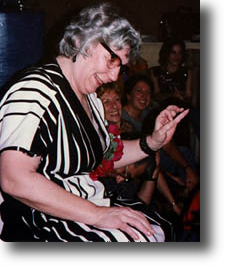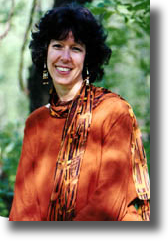| |
Meet the Editors
 Dr.
Drid Williams completed three graduate degrees in Social Anthropology
from St. Hughes College, Oxford, England, and is the architect of a theory
of human actions called 'semasiology'. She has conducted field research
among Carmelite nuns, Dominican friar-preachers and the Royal Ballet company
in England; the Guardian Angels in New York City, and among Cape York
Aboriginal communities in northern Queensland, Australia, and at Moi University
in Kenya, East Africa. She has taught anthropology of the dance and human
movement studies in all four countries. She is the author of numerous
articles on the dance, liturgies, and martial arts. A second, revised
edition of her first book, Ten Lectures on Theories of the Dance (Scarecrow
Press, 1991), retitled Anthropology and the Dance: Ten Lectures, has recently
been published (2004, University of Illinois Press). Dr. Williams has
also edited a special issue of Visual Anthropology (Vol. 8, Nos. 2–4,
1996) entitled Signs of Human Action. She has so far compiled and edited
two volumes in a book series for Scarecrow press: Anthropology and Human
Movement, 1: The Study of Dances (1997) and Anthropology and Human Movement,
2: Searching for Origins (2000). A forthcoming work is Signifying Bodies,
Signifying Acts: New Ways of Thinking About Human Movement. Dr. Williams
is the founder and senior editor of JASHM. Dr.
Drid Williams completed three graduate degrees in Social Anthropology
from St. Hughes College, Oxford, England, and is the architect of a theory
of human actions called 'semasiology'. She has conducted field research
among Carmelite nuns, Dominican friar-preachers and the Royal Ballet company
in England; the Guardian Angels in New York City, and among Cape York
Aboriginal communities in northern Queensland, Australia, and at Moi University
in Kenya, East Africa. She has taught anthropology of the dance and human
movement studies in all four countries. She is the author of numerous
articles on the dance, liturgies, and martial arts. A second, revised
edition of her first book, Ten Lectures on Theories of the Dance (Scarecrow
Press, 1991), retitled Anthropology and the Dance: Ten Lectures, has recently
been published (2004, University of Illinois Press). Dr. Williams has
also edited a special issue of Visual Anthropology (Vol. 8, Nos. 2–4,
1996) entitled Signs of Human Action. She has so far compiled and edited
two volumes in a book series for Scarecrow press: Anthropology and Human
Movement, 1: The Study of Dances (1997) and Anthropology and Human Movement,
2: Searching for Origins (2000). A forthcoming work is Signifying Bodies,
Signifying Acts: New Ways of Thinking About Human Movement. Dr. Williams
is the founder and senior editor of JASHM.
|
|
| |
 Dr.
Brenda Farnell is an Associate Professor of socio-cultural and linguistic
anthropology at the University of Illinois (Urbana-Champaign). Born and
raised in England, she holds a Teaching Diploma from I.M. Marsh College
of Physical Education (Liverpool); a Diploma in Dance and Dance Education
from the Laban Dance Center, Goldsmith's College, London University; an
M.A in the Anthropology of Human Movement from New York University and a
Ph.D. in socio-cultural and linguistic anthropology from Indiana University
(1990). She has done ethnographic research among indigenous peoples of the
Plains region of North America, especially the Nakota (Assiniboine) of Montana
and Kiowa of Oklahoma. Her research interests include ethno-poetics and
performance, Plains Sign Language and dances of the Northern Plains, discourse,
movement literacy, and problems in social theory and embodiment. Dr. Farnell
is also interested in the use of multi-media in indigenous language preservation
and revitalization. She is the author of the book Do You See what I Mean:
Plains Indian Sign Talk and the Embodiment of Action and an award winning
CD Rom, Wiyuta: Assiniboine Storytelling with Signs (U of Texas Press 1995).
She also edited, Human Action Signs in Cultural Context: the Visible and
the Invisible in Movement and Dance (Scarecrow Press 1995). Recent papers
include 'Moving Bodies, Acting Selves' (Annual Review of Anthropology, 1999);
'Getting Out of the Habitus: An Alternative Model of Dynamically Embodied
Social Action', (Journal of the Royal Anthropological Institute 2000); and
'Dynamic Embodiment in Assiniboine Storytelling' (Anthropological Linguistics,
2002). Current research involves a collaborative project with choreographer
Robert Wood of Robert Wood Dance New York Inc. on the choreographic process
and relationships between speech and movement in the making of a contemporary
concert dance work. She has been co-editor of JASHM since 1985. Dr.
Brenda Farnell is an Associate Professor of socio-cultural and linguistic
anthropology at the University of Illinois (Urbana-Champaign). Born and
raised in England, she holds a Teaching Diploma from I.M. Marsh College
of Physical Education (Liverpool); a Diploma in Dance and Dance Education
from the Laban Dance Center, Goldsmith's College, London University; an
M.A in the Anthropology of Human Movement from New York University and a
Ph.D. in socio-cultural and linguistic anthropology from Indiana University
(1990). She has done ethnographic research among indigenous peoples of the
Plains region of North America, especially the Nakota (Assiniboine) of Montana
and Kiowa of Oklahoma. Her research interests include ethno-poetics and
performance, Plains Sign Language and dances of the Northern Plains, discourse,
movement literacy, and problems in social theory and embodiment. Dr. Farnell
is also interested in the use of multi-media in indigenous language preservation
and revitalization. She is the author of the book Do You See what I Mean:
Plains Indian Sign Talk and the Embodiment of Action and an award winning
CD Rom, Wiyuta: Assiniboine Storytelling with Signs (U of Texas Press 1995).
She also edited, Human Action Signs in Cultural Context: the Visible and
the Invisible in Movement and Dance (Scarecrow Press 1995). Recent papers
include 'Moving Bodies, Acting Selves' (Annual Review of Anthropology, 1999);
'Getting Out of the Habitus: An Alternative Model of Dynamically Embodied
Social Action', (Journal of the Royal Anthropological Institute 2000); and
'Dynamic Embodiment in Assiniboine Storytelling' (Anthropological Linguistics,
2002). Current research involves a collaborative project with choreographer
Robert Wood of Robert Wood Dance New York Inc. on the choreographic process
and relationships between speech and movement in the making of a contemporary
concert dance work. She has been co-editor of JASHM since 1985. |
|
| |
Content in Journal for the Anthropological Study of Human Movement
is intended for personal, noncommercial use only. You may
not reproduce, publish, distribute, transmit, participate in the transfer
or sale of, modify, create derivative works from, display, or in any way
exploit the Journal for the Anthropological Study of Human Movement
database in whole or in part without the written permission of the copyright
holder.
ISSN: 2152-1115 |
|

 Dr.
Brenda Farnell is an Associate Professor of socio-cultural and linguistic
anthropology at the University of Illinois (Urbana-Champaign). Born and
raised in England, she holds a Teaching Diploma from I.M. Marsh College
of Physical Education (Liverpool); a Diploma in Dance and Dance Education
from the Laban Dance Center, Goldsmith's College, London University; an
M.A in the Anthropology of Human Movement from New York University and a
Ph.D. in socio-cultural and linguistic anthropology from Indiana University
(1990). She has done ethnographic research among indigenous peoples of the
Plains region of North America, especially the Nakota (Assiniboine) of Montana
and Kiowa of Oklahoma. Her research interests include ethno-poetics and
performance, Plains Sign Language and dances of the Northern Plains, discourse,
movement literacy, and problems in social theory and embodiment. Dr. Farnell
is also interested in the use of multi-media in indigenous language preservation
and revitalization. She is the author of the book Do You See what I Mean:
Plains Indian Sign Talk and the Embodiment of Action and an award winning
CD Rom, Wiyuta: Assiniboine Storytelling with Signs (U of Texas Press 1995).
She also edited, Human Action Signs in Cultural Context: the Visible and
the Invisible in Movement and Dance (Scarecrow Press 1995). Recent papers
include 'Moving Bodies, Acting Selves' (Annual Review of Anthropology, 1999);
'Getting Out of the Habitus: An Alternative Model of Dynamically Embodied
Social Action', (Journal of the Royal Anthropological Institute 2000); and
'Dynamic Embodiment in Assiniboine Storytelling' (Anthropological Linguistics,
2002). Current research involves a collaborative project with choreographer
Robert Wood of Robert Wood Dance New York Inc. on the choreographic process
and relationships between speech and movement in the making of a contemporary
concert dance work. She has been co-editor of JASHM since 1985.
Dr.
Brenda Farnell is an Associate Professor of socio-cultural and linguistic
anthropology at the University of Illinois (Urbana-Champaign). Born and
raised in England, she holds a Teaching Diploma from I.M. Marsh College
of Physical Education (Liverpool); a Diploma in Dance and Dance Education
from the Laban Dance Center, Goldsmith's College, London University; an
M.A in the Anthropology of Human Movement from New York University and a
Ph.D. in socio-cultural and linguistic anthropology from Indiana University
(1990). She has done ethnographic research among indigenous peoples of the
Plains region of North America, especially the Nakota (Assiniboine) of Montana
and Kiowa of Oklahoma. Her research interests include ethno-poetics and
performance, Plains Sign Language and dances of the Northern Plains, discourse,
movement literacy, and problems in social theory and embodiment. Dr. Farnell
is also interested in the use of multi-media in indigenous language preservation
and revitalization. She is the author of the book Do You See what I Mean:
Plains Indian Sign Talk and the Embodiment of Action and an award winning
CD Rom, Wiyuta: Assiniboine Storytelling with Signs (U of Texas Press 1995).
She also edited, Human Action Signs in Cultural Context: the Visible and
the Invisible in Movement and Dance (Scarecrow Press 1995). Recent papers
include 'Moving Bodies, Acting Selves' (Annual Review of Anthropology, 1999);
'Getting Out of the Habitus: An Alternative Model of Dynamically Embodied
Social Action', (Journal of the Royal Anthropological Institute 2000); and
'Dynamic Embodiment in Assiniboine Storytelling' (Anthropological Linguistics,
2002). Current research involves a collaborative project with choreographer
Robert Wood of Robert Wood Dance New York Inc. on the choreographic process
and relationships between speech and movement in the making of a contemporary
concert dance work. She has been co-editor of JASHM since 1985.